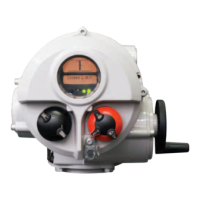If your actuator cannot be installed
immediately store it in a dry place until
you are ready to connect incoming
cables.
If the actuator has to be installed but
cannot be cabled it is recommended
that the plastic transit cable entry plugs
are replaced with metal plugs which are
sealed with PTFE tape.
The Rotork double-sealed construction
will preserve internal electrical
components perfectly if left
undisturbed.
It is not necessary to remove any
electrical compartment covers in order
to commission the IQT actuator.
Rotork cannot accept responsibility for
deterioration caused on-site once the
covers are removed.
Every Rotork actuator has been fully
tested before leaving the factory to
give years of trouble free operation,
providing it is correctly commissioned,
installed and sealed.
3.1 Operating by Hand
WARNING
With respect to handwheel
operation of Rotork electric
actuators, under no circumstances
should any additional lever
device such as a wheel-key
or wrench be applied to the
handwheel in order to develop
more force when closing or
opening the valve as this may
cause damage to the valve and/or
actuator or may cause the valve
to become stuck in the seated/
backseated position.
Fig. 3
To engage handwheel drive, turn
the Hand/Auto lever clockwise whilst
turning the handwheel, see Fig 3. The
lever can now be released upon which
it will return to its original position. The
handwheel will remain engaged until
the actuator is operated electrically
when it will automatically disengage
and return to motor drive. If required
the Hand/Auto lever can be locked in
either position using a padlock with a
6.5mm hasp.
3.2 Operating Electrically
Check that power supply voltage agrees
with that stamped on the actuator
nameplate. Switch on power supply. It
is not necessary to check phase rotation.
Do not operate the actuator
electrically without first checking,
using the infra-red Setting Tool,
that at least the Primary Settings
have been made
(refer to Section
8 page 17).
Selecting Local/Stop/Remote
Operation
The red selector enables either Local or
Remote control, lockable in each position
using a padlock with a 6.5mm hasp.
When the selector is locked in the Local
or Remote positions the Stop facility is still
available. The selector can also be locked
in the Stop position to prevent electrical
operation by Local or Remote control.
Fig. 3.1
Local Control
With the red selector positioned at
Local (anti-clockwise) the adjacent black
knob can be turned to select Open or
Close. To Stop, turn red knob clockwise.
Remote Control
Rotate the red selector to the Remote
position (clockwise), this gives remote
control only for Open and Close but
local Stop can still be used by turning
the red knob anti-clockwise.
3
3
Storage
2
Operating your
IQT Actuator

